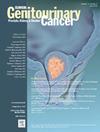The Prognostic Role of 68GA-PSMA-PET/CT in Metastatic Hormone-Sensitive Prostate Cancer: A Preliminary Analysis
IF 2.7
3区 医学
Q3 ONCOLOGY
引用次数: 0
Abstract
Background and objective
In metastatic hormone-sensitive prostate cancer (mHSPC), to evaluate therapy response is currently used conventional imaging and PSA levels. Positron emission tomography with 68Gallium Prostate-specific membrane antigen (68Ga-PSMA-PET/CT) could be useful, although it is not recommended by international guidelines. Its prognostic utility has been already investigated in several works in the castration-resistant setting, but no sufficient efforts have been made to better define it in mHSPC.
Methods
Retrospective monocentric study to preliminary explore the value of 68Ga-PSMA-PET/CT in this setting. We enrolled metastatic patients at the baseline 68Ga-PSMA-PET/CT, treated with androgen deprivation therapy plus docetaxel or androgen receptor signaling inhibitors (ARSI) or both as first-line.
Key findings and limitations
The survival analysis indicated that a Major SUVmax exceeding the cut-off (P = .037) and a SUVmean above the cut-off (P = .025) were linked to improved progression-free survival (PFS) as compared to values ≤ cut-off. While several parameters were associated with undetectable PSA levels at any point after the initiation of first-line therapy, only low-volume disease (HR 7.64, P .002), MTV ≤ cut-off 3-months PSA (HR 5.36, P = .012) and SUVmean ≤ cut-off 3-months PSA (HR 38.6, P < .001) were associated with a higher probability of reaching an undetectable value of PSA in the multivariate analysis. Limitations: retrospective nature, short follow-up time and lack of comparison with conventional imaging.
Conclusion and clinical implications
Lower values of 68Ga-PSMA-PET/CT derived-parameters at baseline are negative prognostic factor, in view of the correlation with lower PFS. This study could help oncologists in the management of mHSPC patients, although further investigations are needed to better understand the prognostic and predictive 68Ga-PSMA-PET/CT role in this setting.
68GA-PSMA-PET/CT在转移性激素敏感前列腺癌预后中的作用初步分析
背景和目的:在转移性激素敏感性前列腺癌(mHSPC)中,评估治疗反应目前使用常规影像学和PSA水平。正电子发射断层扫描68镓前列腺特异性膜抗原(68Ga-PSMA-PET/CT)可能是有用的,尽管国际指南不推荐。它的预后效用已经在一些阉割抵抗设置的工作中进行了调查,但没有做出足够的努力来更好地定义mHSPC。方法:回顾性单中心研究,初步探讨68Ga-PSMA-PET/CT在这种情况下的价值。我们招募了68Ga-PSMA-PET/CT基线转移性患者,接受雄激素剥夺治疗加多西紫杉醇或雄激素受体信号抑制剂(ARSI)或两者作为一线治疗。主要发现和局限性:生存分析表明,与≤临界值相比,超过临界值的主要SUVmax (P = 0.037)和高于临界值的SUVmean (P = 0.025)与改善的无进展生存(PFS)相关。虽然在一线治疗开始后的任何时间点,有几个参数与无法检测到的PSA水平相关,但只有小体积疾病(HR 7.64, P。002)、MTV≤截止3个月PSA (HR 5.36, P = 0.012)和SUVmean≤截止3个月PSA (HR 38.6, P < 0.001)与多因素分析中PSA达到不可检测值的概率较高相关。局限性:回顾性,随访时间短,缺乏与常规影像学的比较。结论及临床意义:68Ga-PSMA-PET/CT衍生参数基线值较低与PFS较低相关,是影响预后的不利因素。这项研究可以帮助肿瘤学家管理mHSPC患者,尽管需要进一步的研究来更好地了解68Ga-PSMA-PET/CT在这种情况下的预后和预测作用。
本文章由计算机程序翻译,如有差异,请以英文原文为准。
求助全文
约1分钟内获得全文
求助全文
来源期刊

Clinical genitourinary cancer
医学-泌尿学与肾脏学
CiteScore
5.20
自引率
6.20%
发文量
201
审稿时长
54 days
期刊介绍:
Clinical Genitourinary Cancer is a peer-reviewed journal that publishes original articles describing various aspects of clinical and translational research in genitourinary cancers. Clinical Genitourinary Cancer is devoted to articles on detection, diagnosis, prevention, and treatment of genitourinary cancers. The main emphasis is on recent scientific developments in all areas related to genitourinary malignancies. Specific areas of interest include clinical research and mechanistic approaches; drug sensitivity and resistance; gene and antisense therapy; pathology, markers, and prognostic indicators; chemoprevention strategies; multimodality therapy; and integration of various approaches.
 求助内容:
求助内容: 应助结果提醒方式:
应助结果提醒方式:


